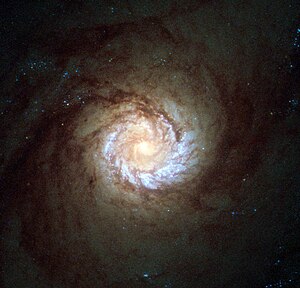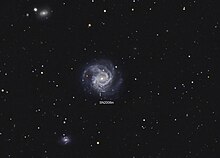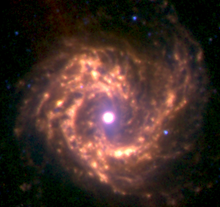Messier 61
| Messier 61[1] | |
|---|---|
 Image taken by Hubble Space Telescope, April 28, 2014[2] Credit: ESA/Hubble & NASA. Acknowledgement: Det58 | |
| Observation data (J2000 epoch) | |
| Constellation | Virgo |
| Right ascension | 12h 21m 54.9s[3] |
| Declination | +04° 28′ 25″[3] |
| Redshift | 0.005224±0.000007[3] |
| Heliocentric radial velocity | 1566±2 km/s[3] |
| Galactocentric velocity | 1483±4 km/s[3] |
| Distance | 52.5 ± 2.3 Mly (16.10 ± 0.71 Mpc) |
| Apparent magnitude (V) | 9.7[4] |
| Characteristics | |
| Type | SAB(rs)bc,[3] HIISy2[3] |
| Apparent size (V) | 6.5 × 5.8 arcmin[3] |
| Other designations | |
| NGC 4303,[3] UGC 07420,[3] PGC 040001,[3] MCG +01-32-022,[3] GC 2878 | |
References: SIMBAD: Search M61 | |
Messier 61 (also known as M61, NGC 4303, or the Swelling Spiral Galaxy) is an intermediate barred spiral galaxy in the Virgo Cluster of galaxies. It was first discovered by Barnaba Oriani on May 5, 1779, six days before Charles Messier discovered the same galaxy. Messier had observed it on the same night as Oriani but had mistaken it for a comet.[5] Its distance has been estimated to be 45.61 million light years from the Milky Way Galaxy. It is a member of the M61 Group of galaxies, which is a member of the Virgo II Groups, a series of galaxies and galaxy clusters strung out from the southern edge of the Virgo Supercluster.[6]
Properties
[edit]M61 is one of the largest members of Virgo Cluster, and belongs to a smaller subgroup known as the S Cloud.[7][8] The morphological classification of SAB(rs)bc[3] indicates a weakly-barred spiral (SAB) with the suggestion of a ring structure (rs) and moderate to loosely wound spiral arms.[9] It has an active galactic nucleus[10] and is classified as a starburst galaxy containing a massive nuclear star cluster with an estimated mass of 105 solar masses and an age of 4 million years,[11] as well as a central candidate supermassive black hole weighing around 5×106 M☉ solar masses.[12] It cohabits with an older massive star cluster as well as a likely older starburst.[11] Evidence of significant star formation and active bright nebulae appears across M61's disk.[13] Unlike most late-type spiral galaxies within the Virgo Cluster, M61 shows an unusual abundance of neutral hydrogen (H I).[14]
Supernovae
[edit]Eight supernovae have been observed in M61, making it one of the most prodigious galaxies for such cataclysmic events.[15][16][5] These include:
- SN 1926A (type II, mag. 14)[17] was discovered by Max Wolf and Karl Wilhelm Reinmuth on 9 May 1926.[18]
- SN 1961I (Type II, mag. 13)[19] was discovered by Milton Humason on 3 June 1961.[20][21]
- SN 1964F (Type II, mag. 14)[22] was discovered by Leonida Rosino on 30 June 1964.[23]
- SN 1999gn (Type II, mag. 16)[24] was discovered by Alessandro Dimai on 17 December 1999.[25]
- SN 2006ov (Type II, mag. 14.9)[26] was discovered by Kōichi Itagaki on 24 November 2006.[27]
- SN 2008in (Type II, mag. 14.9)[28] was discovered by Kōichi Itagaki on 26 December 2008.[29]
- SN 2014dt (type Ia-pec, mag. 13.6)[30] was discovered by Kōichi Itagaki on 29 October 2014.[31]
- SN 2020jfo (Type II, mag. 16)[32][33] was discovered by the Zwicky Transient Facility on 6 May 2020.
Gallery
[edit]-
Spiral galaxy Messier 61 is aligned face-on towards Earth.[34]
-
Messier 61 image using data from Hubble's Wide Field Camera 2
-
Amateur Image of Messier 61 Showing Supernova 2008in on April 16, 2009
-
Infrared image of M61 taken by the Spitzer Space Telescope
-
Messier 61 with SN2020jfo (Supernova) observed on May 15, 2020
-
M61 galaxy image that incorporates data from not only Hubble, but also the FORS camera at the European Southern Observatory’s Very Large Telescope
See also
[edit]References
[edit]- ^ Tschöke, D.; Hensler, G.; Junkes, N. (2000). "X-rays from the barred galaxy NGC 4303". Astronomy and Astrophysics. 360 (2): 447–456. arXiv:astro-ph/0006361. Bibcode:2000A&A...360..447T.
- ^ "A hungry starburst galaxy". ESA/Hubble Picture of the Week. Retrieved 29 April 2014.
- ^ a b c d e f g h i j k l m "NASA/IPAC Extragalactic Database". Results for M 61. Retrieved 2006-11-18.
- ^ "Messier 61". SEDS Messier Catalog. Retrieved 29 April 2022.
- ^ a b "Messier 61". Archived from the original on 2017-01-06. Retrieved 2017-01-11.
- ^ "The Virgo III Groups". Atlas of the Universe. Retrieved 2010-11-27.
- ^ "Galaxy On Line Database Milano Network (GOLDMine)". Archived from the original on 2012-06-03. Retrieved 2012-08-06.
- ^ "The Virgo Cluster". Retrieved 2013-04-06.
- ^ de Vaucouleurs, Gérard (April 1963). "Revised Classification of 1500 Bright Galaxies". Astrophysical Journal Supplement. 8: 31. Bibcode:1963ApJS....8...31D. doi:10.1086/190084.
- ^ Jiménez-Bailón, E.; Santos-Lleó, M.; Mas-Hesse, J. M.; Guainazzi, M.; Colina, L.; Cerviño, M.; González Delgado, Rosa M. (2003). "Nuclear Activity and Massive Star Formation in the Low-Luminosity Active Galactic Nucleus NGC 4303: Chandra X-Ray Observations". The Astrophysical Journal. 593 (1): 127–141. arXiv:astro-ph/0304465. Bibcode:2003ApJ...593..127J. doi:10.1086/376554. S2CID 12969809.
- ^ a b Colina, L.; Gonzalez Delgado, R.; Mas-Hesse, J. Miguel; Leitherer, C.; Jimenez Bailon, E. (2002). "Detection of a Super-Star Cluster as the Ionizing Source in the Low-Luminosity Active Galactic Nucleus NGC 4303". The Astrophysical Journal. 579 (2): 545–553. Bibcode:2002ApJ...579..545C. doi:10.1086/342839. hdl:10261/191615.
- ^ Pastorini, G.; Marconi, A.; Capetti, A.; Axon, D. J.; Alonso-Herrero, A.; Atkinson, J.; Batcheldor, D.; Carollo, C. M.; Collett, J.; Dressel, L.; Hughes, M. A.; Macchetto, D.; Maciejewski, W.; Sparks, W.; van der Marel, R. (2007). "Supermassive black holes in the Sbc spiral galaxies NGC 3310, NGC 4303 and NGC 4258". Astronomy and Astrophysics. 469 (2): 405–423. arXiv:astro-ph/0703149. Bibcode:2007A&A...469..405P. doi:10.1051/0004-6361:20066784. S2CID 849621.
- ^ Koopmann, R.; Kenney, J. D. P. (2004). "Hα Morphologies and Environmental Effects in Virgo Cluster Spiral Galaxies". The Astrophysical Journal. 613 (2): 866–885. arXiv:astro-ph/0406243. Bibcode:2004ApJ...613..866K. doi:10.1086/423191. S2CID 17519217.
- ^ Kenney, J. D.; Young, J. S. (1986). "CO in H I-deficient Virgo cluster spiral galaxies". The Astrophysical Journal Letters. 301: L13–L17. Bibcode:1986ApJ...301L..13K. doi:10.1086/184614.
- ^ Supernovae which have been observed in Messier catalog galaxies
- ^ "List of Supernovae". Central Bureau for Astronomical Telegrams. Retrieved 2011-07-03.
- ^ "SN 1926A". Transient Name Server. IAU. Retrieved 26 November 2024.
- ^ Stromgren, Elis (15 May 1926). "Circular No. 111". Central Bureau for Astronomical Telegrams. Observatoire De Copenhague. Retrieved 26 November 2024.
- ^ "SN 1961I". Transient Name Server. IAU. Retrieved 26 November 2024.
- ^ Thernoe, K. A. (8 June 1961). "Circular No. 1761". Central Bureau for Astronomical Telegrams. Observatory Copenhagen. Retrieved 26 November 2024.
- ^ Humason, M. L.; Kearns, C. E.; Gomes, Alercio M. (1962). "The 1961 Palomar Supernova Search". Publications of the Astronomical Society of the Pacific. 74 (438): 215. Bibcode:1962PASP...74..215H. doi:10.1086/127790.
- ^ Transient Name Server entry for SN 1964F. Retrieved 21 June 2023.
- ^ Petersen, J. Otzen (3 July 1964). "Circular No. 1868". Central Bureau for Astronomical Telegrams. Observatory Copenhagen. Retrieved 26 November 2024.
- ^ Transient Name Server entry for SN 1999gn. Retrieved 21 June 2023.
- ^ Dimai, Alessandro; Li, W. (1999). "Supernova 1999gn in M61". International Astronomical Union Circular (7335): 1. Bibcode:1999IAUC.7335....1D.
- ^ Transient Name Server entry for SN 2006ov. Retrieved 21 June 2023.
- ^ Puckett, T.; Peoples, M.; Itagaki, K.; Nakano, S.; Boles, T.; Kadota, K. (2006). "Supernovae 2006ou, 2006ov, and 2006ow". International Astronomical Union Circular (8781): 2. Bibcode:2006IAUC.8781....2P.
- ^ Transient Name Server entry for SN 2008in. Retrieved 21 June 2023.
- ^ Nakano, S.; Kadota, K.; Wells, W. (2008). "Supernova 2008in in M61". Central Bureau Electronic Telegrams. 1636: 1. Bibcode:2008CBET.1636....1N.
- ^ Transient Name Server entry for SN 2014dt. Retrieved 21 June 2023.
- ^ Nakano, S.; Itagaki, K.; Guido, E.; Nicolini, M.; Howes, N.; Kiyota, S.; Masi, G.; Catalano, P.; Vagnozzi, A.; Munari, U. (2014). "Supernova 2014dt in M61 = PSN J12215757+0428185". Central Bureau Electronic Telegrams. 4011: 1. Bibcode:2014CBET.4011....1N.
- ^ "SN 2020jfo". Transient Name Server. IAU. Retrieved 23 October 2021.
- ^ Boffi, F.R.; Sparks, W.B.; Macchetto, F.D. (1999). "A search for candidate light echoes: Photometry of supernova environments". Astronomy and Astrophysics Supplement Series. 138 (2): 253–266. arXiv:astro-ph/9906206. Bibcode:1999A&AS..138..253B. doi:10.1051/aas:1999274. S2CID 17688690.
- ^ "A portrait of a beauty". www.eso.org. Retrieved 7 January 2019.
External links
[edit]- messier.seds.org/m/m061.html
- Messier 61 on WikiSky: DSS2, SDSS, GALEX, IRAS, Hydrogen α, X-Ray, Astrophoto, Sky Map, Articles and images

![Spiral galaxy Messier 61 is aligned face-on towards Earth.[34]](http://upload.wikimedia.org/wikipedia/commons/thumb/2/23/Messier61_-_ESO_-_Potw1901a.tif/lossy-page1-216px-Messier61_-_ESO_-_Potw1901a.tif.jpg)





